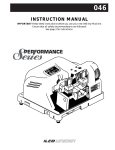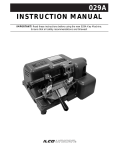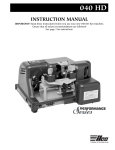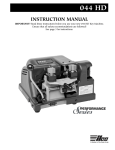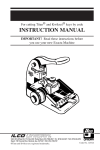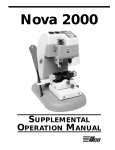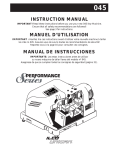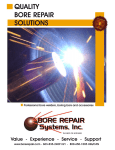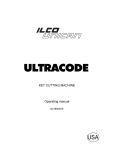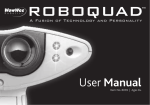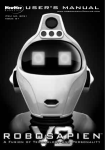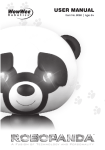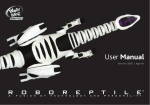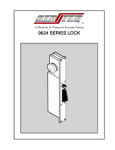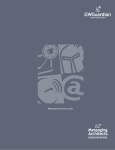Download page heading
Transcript
024B PAGE HEADING INSTRUCTION MANUAL IMPORTANT! Read these instructions before you use your new 024B Key Machine. Ensure that all safety recommendations are followed! See page 2 for instructions. 1 PAGE HEADING This manual is registered and applies specifically to the machine which carries this serial number. It properly identifies your model and assures you will receive correct parts, if and when you require replacement parts. Retain this manual in a safe place. It’s the only one of its kind. If ownership of this machine is transferred, this service manual should accompany the machine. When seeking service information about this machine, refer to Model No. 024B and the part number desired (see pages 6 to 8). Note that many parts are not interchangeable with other ILCO UNICAN machines. CONTENTS Warranty ..............................................................................2 Safety information ................................................................3 Introduction / unpacking ......................................................4 Operating parts (illustrated)..................................................5 Operating parts identification (names and part numbers) ..5 Exploded view ......................................................................6 Exploded view parts list........................................................8 Operating handles / test keys / key cutting ..........................9 How to duplicate keys ........................................................10 The cutting operation..........................................................11 Replacing the cutter ............................................................12 Adjustments ........................................................................13 ONE YEAR LIMITED WARRANTY ILCO UNICAN warrants to the original buyer of any new model 024B machine that it will repair or replace, at its option, any part of any machine which proves, to the reasonable satisfaction of ILCO UNICAN, to have defects arising from the faulty manufacture of the machine or from defective material or components, during a period of one (1) year from the date of shipment of the machine by ILCO UNICAN, provided that the machine is returned by prepaid transport to ILCO UNICAN or to its authorized representative before the expiry of the warranty period together with a detailed description of the alleged defect(s). ILCO UNICAN may, at its discretion, elect to refund the purchase price allowable to the part affected, or to issue a credit if the price therefore remains unpaid. ILCO UNICAN sells precision-made machines. The buyer assumes all risks, and ILCO UNICAN shall not be liable for any reason, if the machine has been subjected to improper installation, improper use, improper or inadequate maintenance, negligence, if any unauthorized modification or alteration is made to the machine, or in case of accident. For greater certainty, any machine not operated in accordance with ILCO UNICAN’s printed instructions or operated beyond its rated capacity shall not be covered by this or any other warranty. 2 Any and all warranties made by ILCO UNICAN on any machine, product, or component thereof shall be effective only if and for so long as the buyer complies with all payment obligations pursuant to the buyer’s accepted and acknowledged order. Failure to meet such payment obligations shall void all warranties and not extend the period of time for which such machine, product of component thereof is warranted irrespective of whether or not payment is eventually made. These warranties are in lieu of and not in addition to any other warranty of condition, expressed or implied, including without limitation merchantability, fitness for a particular purpose or latent defects. The buyer releases ILCO UNICAN from any liability for any reason other than a breach of its warranties hereunder. The liability of ILCO UNICAN shall in no case, including negligence, exceed the purchase price of the defective machine, nor shall ILCO UNICAN be liable for any personal injuries, property damage or consequential damages. Use only genuine ILCO UNICAN replacement parts on this machine! Serial number : ____________________ WARNING – SAFETY PAGE HEADING NOTICE IMPORTANT - Please read carefully before operating machine. Safety begins with education, and continues with proper application. All personnel who operate your machine should read the supplied Operator’s Manual for information on how to properly operate it. The likelihood of accidents and miscuts will be greatly reduced. General safety • Safety glasses must be worn to reduce the possibility of eye injury while operating or in the immediate vicinity of key cutting equipment. • Always turn machine off before making adjustments or inserting or removing keys. • Machine should be located in an area accessible only by authorized operators. Location must be such that customers and other personnel are not subject to potential injury from “flying chips”. • Do not defeat safety features built into your machine. Removal or modification of safety shields, cutter guards, and other safety devices should be strictly forbidden. • At no time should the mechanically-driven parts of the machine be touched while it is in operation. The operator should take care to ensure that loose-fitting clothing, long hair, etc. are kept from the area of machine operation. • Your machine has been specially designed and built for key cutting purposes only and should be operated according to the Operator’s Manual. All other uses are strongly discouraged as potentially dangerous, and should not be attempted! Such use will immediately void the machine’s warranty. • Some states have specific age restriction concerning the operation of certain types of equipment. Check local and state ordinances for compliance. Electrical safety • (120 Volt models) Your machine is designed to operate using 120 Volt A. C. 60 Hz. electrical current. It is supplied with a three-prong power plug which should be used with a properly grounded three-prong outlet only. Do not defeat the safety purpose of the plug by modifying or using with non-grounded outlets! • To reduce risk of fire or electrical shock, do not expose or operate machine in damp or wet locations. • Electrical problems should be referred to qualified repair technicians. If the machine is under warranty, contact ILCO UNICAN at the address printed on the cover. (ILCO UNICAN also offers repair service for out-of-warranty machines. Contact ILCO UNICAN for details.) • Always unplug the machine before removing the hood or changing the cutter wheel. Grounding instructions • In the event of a malfunction or breakdown, grounding provides a path of least resistance for electric current to reduce the risk of electric shock. This machine is equipped with an electric cord that has an equipment-grounding conductor and a grounding plug. The plug must be plugged into a machine outlet that is properly installed and grounded in accordance with all local codes and ordinances. • Do not modify the plug provided - if it will not fit the outlet, have the proper outlet installed by a qualified electrician. • Improper connection of the equipment-grounding conductor can result in a risk of electric shock. The conductor with insulation that has a green outer surface (with or without yellow stripes) is the equipment-grounding conductor. If repair or replacement of the electric cord or plug is necessary, do not connect the equipment-grounding conductor to a live terminal. • Check with a qualified electrician or service personnel if the grounding instructions are not completely understood, or if in doubt as to whether the machine is properly grounded. • Use only 3-wire extension cords that have 3-prong grounding plugs and 3-pole receptacles that accept the machine’s plug. • Repair or replace damaged or worn cords immediately. 3 PAGE HEADING / UNPACKING INTRODUCTION Congratulations! You’ve purchased a superior key cutting machine. The Model 024B semiautomatic key machine you've just purchased incorporates the latest improvements in design for key duplicating machines of its type. The semiautomatic function of the 024B means that the machine itself supplies the proper degree of pressure against the machine’s carriage during the key duplication process and that the “tracing” motion of the carriage while duplicating a key is controlled by simply moving a lever! In essence, the model 024B duplicates keys with more consistent accuracy and greater speed, especially important in situations where several employees operate the machine during the course of the day. Featuring exclusive four-way vise jaws, the model 024B is designed to accommodate virtually any standard cylinder key without the need for adapters. Even doublesided automotive keys can be duplicated with ease; the four-way jaws include stations ideally suited to gripping these keys and is capable of gripping them in the groove or milling for enhanced clamping performance when necessary. (See illustration on page 10). Unpacking instructions Your 024B key machine has been shipped to you in a sturdy, specially-cushioned container to prevent the possibility of damage during handling and shipment. Once the machine is removed from the carton, it should be set up on a level workbench and wiped free of all rustproof- ing oil. The machine is adjusted at the factory and test keys have been cut on it, but it is recommended that you check the adjustments to make sure they have not slipped or shifted during transit (see page 13 “Adjusting for depth of cut”). Safety The 024B has been engineered to duplicate cylinder (paracentric) keys. It is not intended or designed for any other purpose. The machine operator assumes all liability when using this machine in a manner inconsistent with its stated design purpose. Refer to page 3 for complete safety information before operating the machine. ILCO UNICAN strongly recommends the use of protective eye glasses or goggles when operating this machine, CAUTION! 4 or when in the vicinity of the machine while it is being operated. Protective eye wear prevents injuries! The machine should be turned off before loading or unloading keys. When the key machine is operating, be careful not to contact the vise jaw or carriage against the cutting wheel as this will cause damage to the cutter, jaw, or carriage. DO NOT DESTROY OR DISCARD THIS VALUABLE SHIPPING CARTON. STORE IT CAREFULLY IN A SAFE PLACE. THIS CARTON SHOULD BE USED WHENEVER THE MACHINE IS MOVED OR SHIPPED. PAGE ADJUSTMENTS HEADING Adjusting for depth of cut Adjusting for spacing To ensure safety, UNPLUG machine from its power source before adjusting for depth of cut. It's imperative that the key guide and the cutter be in the same plane, that is, aligned to each other. If the cutter guide protrudes further than the cutter, the resulting cuts in a key blank will be too shallow and the duplicate key will not work. Likewise, if the cutter guide is behind the cutter, the cuts in the key will be too deep (see Fig. 9). There is no adjustment for spacing. However, if a key gauge assembly is ever replaced, the key gauge must be fitted to the machine after it has been installed. To do this, first install a pattern key and key blank and align these against the cutter guide and cutter. Then lower the key gauge and file the appropriate finger of the gauge to allow contact with the shoulder of both keys. Adjusting the Carriage Stop Figure 9 Adjustment is correct when both key blanks touch To check the depth adjustment, insert two identical key blanks into the vise jaws, setting them flat in each vise. (It is not necessary to align the blanks.) Then, raise the carriage, positioning the left blank against the cutter guide and the right blank against the cutter. Next, turn the machine pulley by hand and note the right key blank. The cutter should just barely graze the key blank when the adjustment is correct. No cutter is perfectly round so make one complete rotation of the cutter before changing adjustment. There will be a high point on the cutter; the adjustment should be made to the high point. If the cutter does not touch the key blank after one rotation, proceed to change the adjustment. To adjust cutter guide, loosen the binding screw on top of the guide. With a flat screwdriver, turn adjusting screw in (to increase depth) and/or out (to decrease depth). See Fig. 10. Figure 10 Binding screw The purpose of the carriage stop is to prevent the cutter from hitting into the right vise jaw. The stop is a nut and bolt and is adjustable (see Fig. 11). To check the adjustment, raise carriage (without keys in vise jaws) and rotate the cutter by hand. The cutter should not contact the vise jaw. When the carriage stop is properly adjusted, there should be a space of .008" between the vise jaw and the cutter (this is about the thickness of an ordinary business card). Do not allow a greater distance since this may affect the depth of cut. Cleaning Your machine should be kept clean of all filings and dust. The most critical areas are the carriage jaws and shafts. A one inch paint brush is ideal to brush these areas of the machine. The shafts should be wiped periodically with a lightly oiled cloth. We suggest brushing the jaws often as even a single filing can alter the accuracy of the machine. Lubrication Intervals Lubricating of moving parts is important. An oil cup is provided to keep the cutter shaft bearings well lubricated (57 drops of 3-in-1 or lightweight spindle oil in the oil cup is sufficient.) The carriage spindle should be lubricated with a thin film of oil and wiped free of chip build up. The lubrication procedures should be performed every 2-3 weeks depending on usage. The motor requires lubrication on an annual basis. See motor label for details. Circuit Breaker Adjusting screw (Depth of Cut) Carriage stop adjusting screw To protect against machine damage in the unlikely event the unit jams while duplicating a key, your 024B is equipped with a circuit breaker. Should it activate, turn the power switch to the off position, pull the carriage back to the “load” position , and press the circuit breaker button in to reset. At this point the machine will run once the power switch is again placed in the “on” position Repeat the cutting procedure to complete the unfinished duplicate. 13 PAGECUTTING THE HEADING OPERATION / REPLACING THE CUTTER General operating sequence General operating sequence (cont.) WARNING: Do not install or remove keys unless the off/on switch is in the off position. Always wear eye protection when operating this machine! 1. Rotate both vise jaws to the station suitable for the key being duplicated. 2. Insert the blank key and pattern key into the vise jaw using the appropriate method described under “Aligning keys in the vise jaws”. Be sure that both keys are laying level in the vise jaws and are not tilted. 3. After the keys are Figure 7 aligned, move the carriage lever to the right (clockwise) until the cutter guide is slightly left of the cut closest to the head of the pattern key (See Fig. 7). 4. Press the off/on switch to the “ON” position. 5. Push down on the carriage handle while pulling out on the carriage trigger (See Fig. 8). 6. The carriage movement is controlled by the carriage lever. Using slow to moderate speed, smoothly move the carriage lever to the left (counter clockwise). Avoid using an erratic, jerking movement! Once the cutter is at the tip of the key, move the carriage to the right by moving the carriage lever clockwise. This will result in a second cutting pass over the key blank. STOP before cutter contact with the shoulder of the blank occurs. 7. Press the off/on switch to the ‘off’ position and remove finished key by pushing down on the carriage handle until the trigger clicks into place. Then loosen wing nut to remove duplicate key. 8. To deburr the key, turn the machine on, and position the cut key lightly against the rotating deburring brush. Figure 8 Carriage handle Trigger (pull out to release) This will allow you to ease the carriage up into cutting position. Take care to ensure that the carriage does not “slam” forward as this will result in probable cutter damage. Remember, best results are obtained if the cutter guide makes initial contact slightly left of the cut closest to the head of the pattern key. Do not permit the cutter to touch the shoulder of the key blank. 12 Replacing the cutter The CU20 cutter used on this machine is 21⁄4" in diameter, .250" thick (1⁄4") and has a 1⁄2" hole. It's a milling cutter, made out of high speed steel. It has a flat left side, which is excellent for making deep cuts, when these cuts are next to the shoulder, such as on GM, Chicago, etc. No warranty is placed on the cutter, operators should treat it with care and avoid harsh usage. Do not force the carriage up, causing the key blank to bang into the cutter, and do not apply heavy pressure when cutting. Also, do not let the cutter cut into the vise jaw; this will dull the cutter quickly. As with any metal cutting instrument, the CU20 will dull with usage. There are three ways to tell when a cutter is dull and requires replacing: 1. Time - a dull cutter takes longer to make the cuts. 2. Sound - a dull cutter will emit a shrill sound as it runs across the key blank. 3. Burrs - a dull cutter will not cut away the metal but will roll it away. When this occurs, there will be a buildup of metal burrs on the underside of the key. If this buildup is heavy, the cutter is dull. A sharp cutter leaves little or no burrs. To replace cutter, use two wrenches, one 3⁄4" wrench for cutter nut and one 1⁄2" wrench for cutter shaft. Set the two wrenches in position and loosen the cutter nut. Note that the cutter nut has a reverse thread and turns “downward” to loosen. Remove the spacer washer and the dull cutter. Install the new cutter, the washer and the nut. OPERATING PAGE HEADING PARTS Safety hood assembly Cutter guide (stylus) Safety shield Oil cup Key gauge Nylon brush CU20 Cutter Wing nut Carriage Carriage lever assembly Circuit Breaker On / Off power switch Vise jaw assembly Trigger assembly Carriage handle assembly Operating parts identification Part no. Identification 024B-1 024B-3X 024B-8 Carriage Vise jaw assembly Wing nut 024B-9X 024B-11X 024B-35X Carriage handle assembly Trigger assembly Carriage lever assembly 024B-38 024B-43 024B-49A CU20 cutter Nylon brush Cutter guide (stylus) 024B-56 024B-61 024B-62A Key gauge Circuit Breaker On/Off power switch 024B-82 024B-86X 024B-87 Oil cup Safety hood assembly Safety shield 5 PAGE HEADING EXPLODED VIEW 6 THE CUTTING PAGE OPERATION HEADING Aligning keys in the vise jaws Keys with shoulders WARNING: Do not install or remove keys unless the off/on switch is in the off position. Both the pattern key and the key blank must be properly aligned and securely clamped in the vise jaws prior to duplication. The correct procedure to do this follows: 1. Move the carriage lever to the left as far as possible (See Fig. 3) Figure 3 Figure 4 2. Assure that both vise jaws are rotated to the correct position for the type of key being duplicated. 3. Place the key blank in the right hand jaw. Position it so that it is parallel with the front portion of the jaw (See Fig. 4). Tighten wing nut lightly. 4. Swing key gauge down to rest on the blade of the key blank. Slowly move carriage lever clockwise to the right until the shoulder of the key blank butts up against the edge of the key gauge (See Fig. 5). 5. Use index finger to press down on the front edge of the key blank while loosening wing nut. Retighten securely after assuring that the key blank is contacting key gauge and is properly seated in the vise jaw. 6. Position pattern key in the left vise jaw repeating the procedure described in step 4. 7. Check to ensure that the pattern key and blank key's shoulders are snug against the key gauge and both keys positioned level (not tilted) in the vise jaws. Return key gauge to the “up” position. The key is now properly aligned for duplication. Aligning keys in the vise jaws Keys without shoulders On keys that don't have a conventional shoulder, such as the Ford doublesided key, the tip of the key is used as the aligning point. With keys of this type follow this procedure: 1. Assure that both vise jaws are rotated to the correct position for the type of key being duplicated. 2. Position the key blank in the right hand jaw. For most tip gauged automotive keys, position the blank so that the tip is roughly 1/4" left of the jaws right edge. Tighten the jaws wing nut securely. 3. Move the carriage lever to the left so that the key gauge's right hand “finger”, with the gauge lowered, is just forward of the key blank's tip. 4. Insert the customer's key (pattern key) in a similar manner in the left hand jaw. Then position both the customer's key and the key blank so that their tips are both in direct contact with the left edge of the key gauge fingers (see figure 6). Figure 6 tip tip Figure 5 shoulder shoulder Key gauge Lift up 5. After both the customer's key and blank key are aligned, lift key gauge to its “raised” position. 6. If a key is cut on both sides, after duplicating “side one” rotate and proceed with “side two” using the same alignment procedure. In the case of Ford keys as well as most doublesided European and Japanese double sided keys, only the blank needs to be rotated as the cuts are the same on both sides. 7. Refer to page 12 for additional information covering the actual key duplicating process. 11 PAGE TO HOW HEADING DUPLICATE KEYS General key duplication procedures Using the four-way vise jaws (cont.) WARNING: Do not install or remove keys unless the off/on switch is in the OFF position! Always wear eye protection when operating this machine! To obtain the best gripping action possible, it is necessary to assure that the proper vise jaw position is selected for each key you duplicate. The vise positions are explained below and proper usage shown in figure 2. There are four procedures that the machine operator performs to insure proper duplication of a key: 1. Selection of the proper key blank. Compare the head, length, and key blank's cross section (width, angle, and location of grooves) with the key to be duplicated to assure that a proper match has been made. 2. Ensuring both four-way vise jaws have been placed in the proper position for the type of key to be duplicated. See “Using the four-way vise jaws” section of this manual. 3. Proper alignment of the pattern key and blank key within the vise jaws. See “Aligning keys in the vise jaws”. 4. Actual duplication of the pattern key; which can be properly accomplished only after the previous steps are performed. Standard - for holding regular cylinder keys, such as house keys, single sided automotive keys, padlock keys, with one or two shoulders. Narrow - for holding the 1092B and other narrow width keys. Wide - for holding the Ford double-sided keys and similar types, either primary or secondary. When positioning the keys in the vise jaws, lay the key so that its center ledge is flat against the top surface of the jaw. X - Ideal for holding most double-sided convenience keys used on most current automobiles. Grip these keys by the grooves rather than the blade edge where the cuts are located (see Fig. 2). Figure 2 Using the four-way vise jaws Your 024B is equipped with the ILCO UNICAN versatile Four-way, Super Jaw 2 vise jaws. They feature four unique clamping surfaces to securely grip virtually any typical cylinder key (see Fig. 1). Super Jaw 2 vise jaw shown gripping a typical automotive key Figure 1 Using standard position Using X position To reposition the vise jaws, as from Standard to Wide, Rotate both jaws as a set Using wide position Using narrow position first loosen the wing nuts. Then lift upward on the top and bottom of each vise jaw as a complete unit to raise them above their seat in the carriage. Rotate the jaws until the chosen vise position is facing toward the rear of the machine and lower the jaws back into contact with the carriage. Both left and right vise jaws should be rotated to the same position. 10 EXPLODED PAGE HEADING VIEW 7 PAGE HEADING EXPLODED VIEW PARTS LIST Refer to pages 6-7 for illustration 8 Ref. Part no. Description 1 1X 2 3X 024B-1 024B-1X 024B-2 024B-3X Carriage Carriage assembly Carriage stud Vise jaw assembly 4 6X 8 9X 024B-4 024B-6X 024B-8 024B-9X 11X 16 17 18 Ref. Part no. Description 56 57 58 59 024B-56 024B-57 024B-58 024B-59 Key Key Key Key Vise jaw spring Thrust bearing set Wing nut Carriage handle assembly 60 61 62A 68 024B-60 024B-61 024B-62A 024B-68 Cap screw, 8-32 x 1⁄2" Circuit Breaker, ETA 1658 On/Off switch Electrical cover 024B-11X 024B-16 024B-17 024B-18 Trigger assembly Carriage torsion spring Washer Screw, 10-32 x 1⁄2" 70 74 75 79 024B-70 024B-74 024B-75 024B-79 Rubber Mount Truss head screw, 8-32 Motor, 1⁄4 hp, 115V, C/S Key gauge spring 20 21 23A 24 024B-20 024B-21 024B-23 024B-24 Cutter shaft bushing Carriage shaft bushing Carriage shaft Pivot Block 82 84 85 86 024B-82 024B-84 024B-85 024B-86 Oil cup Crescent ring 024B-110V nameplate Safety hood 25 28A 29A 32 024B-25 024B-28 024B-29A 024B-32 Pinion shaft bushing Pinion shaft Set screw, 1⁄4-20 x 5⁄16" Socket hd. screw, 10-24 x 3⁄8" 86X 87 88 89 024B-86X 024B-87 024B-88 024B-89 Safety hood assembly Safety shield Shield screws, 10-32 x 1⁄2" Flat washer, #10 34 35 35X 36 024B-34 024B-35 024B-35X 024B-36 1 ⁄4" lockwasher Carriage lever Carriage lever assembly Cutter nut, N-4 90 91 92 101 024B-90 024B-91 024B-92 024B-101 Nut, #10-32 Power cord 3 wire motor cable Motor pulley set screw 37 38 40A 41 024B-37 024B-38 024B-40A 024B-41 Cutter spacer CU20 cutter Cutter shaft Cutter shaft pulley 106 109 110 111 024B-106 024B-109 024B-110 024B-111 Chip Tray Bearing washer Wave washer 024B Yoke 43 45 46A 47 024B-43 024B-45 024B-46A 024B-47 Nylon brush Brush bolt washer, 5⁄16 Hex head screw, 5⁄16-18 x 3⁄4 Motor pulley 2" - 3L 112 113 114 115 024B-112 Socket head screw, 10-32 x 3⁄4" 024B-113 Roll pin 024B-114 Torque arm 024B-115 Shoulder screw 48 49A 50 51 024B-48 024B-49A 024B-50 024B-51 V-Belt, 3L-180 Cutter guide (stylus) Cutter guide roller Guide roller bushing 160 171 177 178 024B-160 024B-171 024B-177 024B-178 Caution label Cutter pulley set screw, 3⁄8" -18 Ext. retaining Ring Washer 52 53 54 55 024B-52 024B-53 024B-54 024B-55 Socket head screw, #8-32 X 15⁄8" Cutter guide binding washer Cutter guide binding screw Adjusting screw 179 180 181 182 024B-179 024B-180 024B-181 024B-182 #10-32 x 3/4 SCHS Mount Plate Key Gauge Spacer - Left Key Gauge Spacer - Right 183 184 185 IM 024B-183 024B-184 024B-185 024B-IM 1/4-20 Lockwasher 1/4-20 Hex Nut Plate - Chip Guard Instruction manual NS 024B-240 220V 1⁄4 HP motor gauge gauge bracket gauge dowel pin gauge housing (two) OPERATING HANDLES / TEST KEYSPAGE / KEY HEADING CUTTING Operating handles Proper key cutting techniques The 024B key machine is shipped completely assembled except for the carriage handle and the lever handle. Upon unpacking the machine, locate the carriage handle and thread it into the carriage in the area directly above the trigger assembly. Then, cut the nylon band holding the carriage rigid and insert the lower end of the lever handle into the hole in the pinion shaft (located at the front of the machine on the left side). Tighten the set screw on the front of the pinion shaft to secure the lever handle, Refer to page 5 if unsure of handle placement. Even though your 024B key machine is designed to make key cutting fast, easy and accurate, operator technique is important. The actual mechanics of placing keys within the vise jaws are simple to learn, but there are some basics that must be followed. A properly adjusted key machine used by someone who ignores good key cutting technique will NOT produce a good key. The way a person clamps a key into the vise jaws is critical to the accuracy of the duplicated key. Test keys A series of cut keys are supplied with your machine. These keys were cut on your machine and represent the result of our quality inspectors' work before approving your machine for shipment. The keys are reproductions of factory-dimensioned pattern keys and are accurate to .002" or less. Save these keys and use them as standards to check the accuracy of cuts in the keys you make. By measuring across the cuts with a micrometer, you'll be able to see if your machine is cutting too deep or too shallow, thus indicating that an adjustment of the cutter guide is necessary. Remember - the real purpose of a duplicate key is to operate the lock for which it was intended. If customers return keys, you should reexamine your cutting techniques and adjustment of the machine. Here are some important operating tips: 1. Vise jaws - clean them regularly so that no metal chips lie under the keys. It is essential that both keys lie flat across the entire width of each vise jaw. Neither key should be tilted. 2. Do NOT use pliers or other tools to tighten the vise jaws. Firm hand pressure is sufficient. 3. Keep the carriage shaft free of metal chips. A thin film of oil can be applied to it. The carriage should be free to move without binding. 4. NEVER touch the shoulder of a key to the side of the cutter guide. This will cause the shoulder of the key blank to touch the side of the cutting wheel. When this happens, some of the metal will be cut away from the shoulder of the key blank. If the resulting duplicated key is duplicated two, three, four times over, an error will accumulate and cause a nonoperating key. Do not grind away the shoulder. 5. Don't run the cutter into the vise jaw; this will dull the cutter, and reduce cutter efficiency. 6. Keep the cutter clean. Don't let any foreign objects or instruments blunt it. This cutter is a precise cutting tool and should be handled with care. 7. Lubricating of moving parts is important. An oil cup is provided to keep the cutter shaft bearings well lubricated. (5-7 drops of 3-in-1 or lightweight spindle oil in the oil cup is sufficient.) The carriage spindle should be lubricated with a thin film of oil and wiped free of chip build up. The lubrication procedures should be performed every 2-3 weeks depending on usage. The motor requires lubrication on an annual basis. See motor label for details. 9 14 15 USA ILCO UNICAN CORP. 400 Jeffreys Rd., Rocky Mount, NC 27802-2627 Tel.: (919) 446-3321 • (919) 446-4702 After March 22, 1998 area code changes to 252 Canada and international ILCO UNICAN INC. 7301 Decarie Blvd., Montreal, Quebec H4P 2G7 Tel.: (514) 735-5411 • (514) 735-4704 Export Fax: (514) 735-1393 Printed in USA 125000 16
















